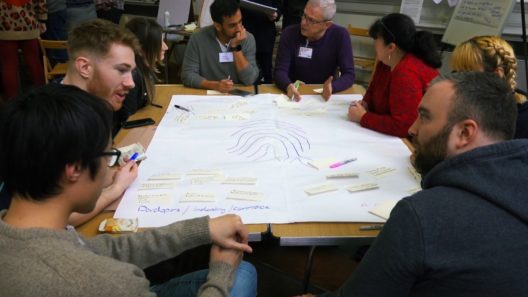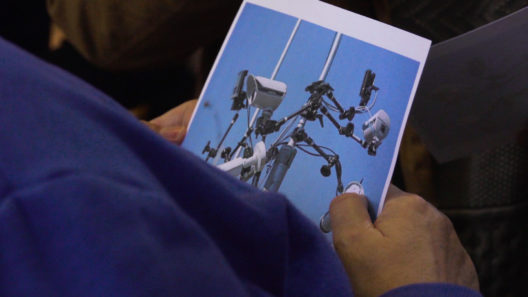Why we cannot afford to leave technology to the experts – the case for public engagement at times of crisis
Discussing the profound societal challenges raised by developing technologies as central to government strategies in responding to COVID-19.
13 May 2020
Reading time: 7 minutes

Governments across the world have opted to develop technologies, such as digital contact tracing, symptom tracking, and the creation of data stores as central to their strategies in responding to COVID-19.
These raise profound societal challenges as our recent report, Exit Through the App Store , and the media debate around NHSX’s contact tracing app have already shown. The widespread debate brings out systemic deficits that illustrate why we cannot afford to leave technology to the experts.
First is the deficit of tech problemism – where we simplify complex problems to create simpler solutions; overlooking the importance of the diverse and collective insights required to realise complex systemic change. Second is the deficit of technocracy; the temptation to reach, through technical solutions, for models of technology-led decision making that are ill-equipped to navigate conditions of uncertainty, or secure high levels of public support and legitimacy. Public engagement can help to address these deficits by drawing on a range of values and perspectives.
1. Public engagement enables us to address the deficit of tech problemism – simplifying complex problems to yield simplistic (tech) solutions
Evgeny Morozov has argued that the primary peril of the sudden and dramatic turn to technology is the risk of ‘solutionism’. Solutionism is born of the belief that all difficulties; even deeply complex ones, can be solved by relatively benign solutions, which are often of a technical nature. And these can have unforeseen consequences. It is highly unlikely, for instance, that those who designed what would become the smartphone back in the early 1990s could have anticipated it being considered the ‘go-to’ solution for resolving the challenges the current pandemic presents.
We can build upon Morozov’s analysis; tech solutionism in turn lends itself to tech problemism. Making the solution a technological one risks that we simplify the problem as well; in doing so, the creativity, scope and potential of our social change solutions are considerably more constrained than they could or ought to be. While solutionism works well for the purveyors of smartphones and digital contact tracing apps, it works less well for those looking for multi-faceted interventions to resolve complex problems. What does work, however, in solving complex problems – as the research of Scott E. Page illustrates – is finding a way to harness diversity and collective intelligence in tackling them. Page’s research finds that groups of diverse problem solvers can outperform groups of high ability problem solvers.
Against the backdrop of COVID-19, what kind of problems have been simplified in the rush for a tech solution, and how do we find ways of embracing them in all their messy, glorious complexities, so as to produce better solutions? These include the public health problem of understanding how COVID-19 works as a disease, how it spreads, and how immunity is generated. Only once we have a clearer picture of these dynamics, does it feel that we can design technologies that are effective in contact tracing or immunity certification (let alone societally acceptable). There are also the institutional questions of how we ensure we build public confidence and legitimacy in the government and the NHS’s strategy at these times, and secure trust in the approaches and the outcomes – vital, if the messages, the strategy, and yes, even the technology, are to work. Meaningful public engagement is central to enabling effective exploration of these questions.
2. Public engagement enables us to address the deficit of technocracy – placing experts on top, not on tap
A second deficit is that of technocracy – confining decisions about the use and deployment of technology to the experts without adequate scope for a wider societal and public debate and conversation. This is a challenge even at the best of times, but other factors, such as time pressures on governments to respond swiftly and to be perceived to be dealing competently and effectively with such crises, exacerbate the problem. We have only to look at how the public debate around technological solutions to the COVID-19 crisis has narrowed to understand the risk that emerges. Complex questions such as the following are all at risk of being redefined in ways that narrow the sphere of public conversation;
- What conditions would generate public trust in the widespread use and adoption of these technologies? How are people’s experience of such technologies changing their attitudes and their norms to technology?
- How, why, when, and on whose terms we return to the ‘new normal’? What should the ‘new normal’ even be? What role might technology play in defining the ‘new normal’?
So, in lieu of debating the boundaries of acceptability and public expectations, we find ourselves instead constrained to debating whether the apps we deploy ought to be centralised or decentralised, which is a conversation open only to technical experts, to whether the GDPR can/does/should apply (a conversation open only to legal experts), or what the potential economic ramifications of a tech enabled early exit, and how to balance that against public health considerations might be (a conversation open only to economic and public health experts). The effect is to lock out the intelligent and critical layperson from a legitimate public debate about the potential, risks and limitations of technologies, and probably the opportunity to answer the most important question – what conditions would secure public confidence in the use of technologies in addressing what is perhaps the most significant societal crisis we have experienced in the past decade?
Technocracy usually manifests in tech, commercial, and policy circles as ‘DAD’ – ‘decide, announce, and defend’ – a mode through which an experts and/or politicians rapidly assemble a solution, announce the solution to the world at large, lock the metaphorical door and await the media, (and social media) backlash to hammer down upon them. While DAD undeniably has its uses, it generally does not work well when outcomes and futures are uncertain; when a range of technical, social and cultural variations are influencing the outcomes; when successful implementation involves a lot of people; and when people are not in an obvious command structure, but can choose whether or not to cooperate; as experienced facilitator Penny Walker argues. These are the exact conditions that are currently at stake to ensure that technologies enabling an exit strategy (and indeed, the deployment of technologies more generally to respond to COVID-19) are a success.
3. Ada’s approach to deliberative public engagement and what we are doing to make a contribution in this space
Here at Ada, we see our role as ensuring that data and AI work for people and society – and that includes developing the mechanisms through which we can ensure society and citizens are truly ‘in the loop’. We wish to see a shift from the ‘DAD’ approach to the approach commonly described as ‘EDD’ – engage, deliberate, and decide. If the problems that we are faced with are societal, not purely technological or technocratic, then success lies in ensuring that people and society have the tools and resources they need to be able to shape the debate about technologies. Public engagement has been a core component of our work– through engaging publics and civil society on how we can and must rethink data narratives, through the citizen juries we have convened on health data NHS and commercial partnerships, and the deep deliberative conversations we have hosted through our flagship Citizens’ Biometrics Council.
Still, some might ask, even if we wanted to – is it possible to engage the public in a meaningful way online? Some trends are suggesting that, while face-to-face engagement undeniably has its strengths, digital public deliberation, designed and run well, might also have strengths; complementing face-to-face approaches. The successful shift online of the Climate Citizens’ Assembly, for instance, has demonstrated that even in the unusual times of lockdown, it is still possible to do public deliberation. Other examples of large scale deliberations – across nation states for example, include World Wide Views, run by the Danish Board of Technology Foundation have successfully overcome barriers of distance and language – merging face-to-face deliberation with online technologies to enable international plenaries. In what now seems like a technological age ago (five years ago, precisely), I had begun experimenting with digital public engagement for the government run programme Sciencewise, and learning lessons from some very early prototypes. Besides, this crisis has challenged established norms and expectations about how we live, travel and work. Why should public engagement be an exception?
This week we are launching the pilot of an online deliberative process, working with Traverse and Involve to trial a rapid, online deliberation with 25–30 demographically diverse members of the public to talk about COVID-19 exit strategies through the lens of technologies over a period of three weeks, as a demonstrator initiative. In running this project, we wish to gain a deeper understanding into what it means for public confidence and legitimacy in the use of technologies to be created and shaped, especially at times of crisis. You can find out more about this project online here.
Related content

Turning distrust in data sharing into ‘engage, deliberate, decide’
Five lessons from the GP Data for Planning and Research scheme (GPDPR)

How to make a Citizens’ Biometrics Council
Answers to some of the most frequently asked questions about how we ran the Citizens’ Biometrics Council

The Citizens’ Biometrics Council
Report with recommendations and findings of a public deliberation on biometrics technology, policy and governance

Public dialogue on the ethics of location data
A partnership with Traverse, the Geospatial Commission and Sciencewise to understand public perspectives on the responsible use of location data.